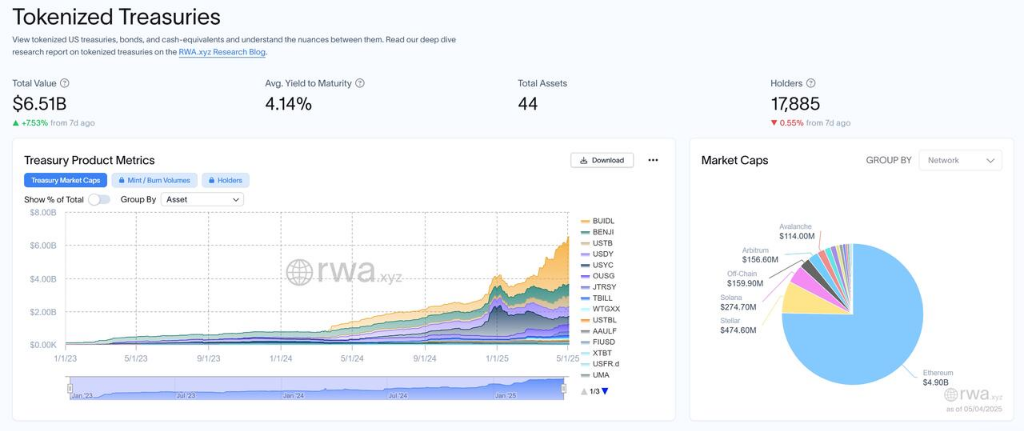The wave of real-world asset (RWA) tokenization is sweeping through the financial world, transforming from an abstract concept into a practical financial tool.
Institutional investors are massively testing and deploying their infrastructure. Just last week, traditional financial institutions and native blockchain companies, including BlackRock, Libre, and others, have announced initiatives to advance their RWA plans.
Marcin Kazmierczak, co-founder of RedStone, stated that recent announcements "demonstrate that tokenization has moved from theoretical discussions to practical applications by market leaders".
Ethereum remains the primary hub for RWA tokenization, with RWA.xyz data showing the current market value of tokenized US Treasury bonds at $6.5 billion. Ethereum dominates the market, hosting over $4.9 billion in tokenized government bonds.
Piscini estimates that by the end of this decade, over 10% of global financial assets may be tokenized. However, whether this promise will be fulfilled remains to be seen.
Giants Converge: RWA Tokenization Accelerates
On April 30th, BlackRock submitted an application to create a digital ledger technology share class for its $150 billion Treasury Trust Fund. It will use blockchain technology to maintain a mirrored record of share ownership for investors. This DLT share will track BlackRock's BLF Treasury Trust Fund (TTTXX), which can only be purchased from BlackRock Advisory and Bank of New York Mellon (BNY).
MultiBank Group signed a $3 billion RWA tokenization agreement with UAE real estate company MAG and blockchain infrastructure provider Mavryk. This is reportedly the largest RWA tokenization plan to date.
Hashgraph CEO Eric Piscini told Cointelegraph:
"The recent surge is not coincidental, as everything is moving in a favorable direction. Market rules are becoming clearer, technology is more powerful and faster, and is ready to scale. Giants like BlackRock are taking actual action—BlackRock is tokenizing funds, Citibank is exploring digital asset custody, and Franklin Templeton has already tokenized money market funds on public blockchains."
Kazmierczak stated that renewed interest in RWA tokenization is primarily driven by Trump's crypto-friendly government and an increasingly clear regulatory environment.
Since Trump's election victory, the SEC has dropped or suspended over a dozen enforcement cases against crypto companies. Moreover, the Department of Justice recently announced the dissolution of its crypto enforcement unit, indicating a softening attitude toward the industry.
Beyond regulatory clarity, technological advancements in wallets have also played a crucial role in driving tokenization adoption. Felipe D'Onofrio, CTO of Brickken, stated:
"Meanwhile, macroeconomic pressures are compelling institutions to seek efficiency and liquidity in traditionally illiquid markets."
Ethereum's Dominance: Primary Hub for RWA Tokenization
Ethereum remains the primary hub for RWA tokenization, thanks to its mature ecosystem, extensive developer support, and robust infrastructure. Kazmierczak noted:
"Due to its unparalleled security, developer ecosystem, and institutional adoption, Ethereum remains the most suitable blockchain for large-scale RWA issuance."
However, he pointed out that specialized RWA ecosystems like Canton Network, Plume, and Ondo Chain are building compelling alternatives with features designed for compliant asset tokenization.
According to RWA.xyz data, the current market value of tokenized US Treasury bonds is $6.5 billion. Ethereum dominates the market, hosting over $4.9 billion in tokenized government bonds.

Challenges Remain: Enormous Growth Potential
However, obstacles persist. Regulation remains a significant barrier, especially for risk-averse institutions requiring assurances around compliance and privacy. Additionally, technological limitations continue to exist, primarily due to lack of interoperability between blockchain platforms.
Looking ahead, Piscini estimates that over 10% of global financial assets may be tokenized by the end of this decade. D'Onofrio also made a moderate prediction, estimating that 5% to 10% of global financial assets might be tokenized by 2030. RedStone's Kazmierczak predicts that approximately 30% of the global financial system will be tokenized by the end of this decade.
In numerical terms, STM.co predicts the global RWA market size will be between $30 trillion and $50 trillion by the end of 2030. Most companies forecast the RWA market size between $4 trillion and $30 trillion by 2030.
According to a Tren Finance research report, if the industry reaches the predicted median of around $10 trillion, it would grow more than 50 times its current value (approximately $185 billion, including the stablecoin market).







